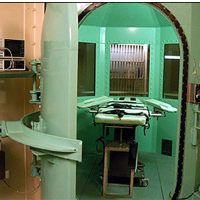Appellate Court Puts California Death Penalty on Ice Again
 San Quentin State Prison death chamber (photo: Agence France-Presse
San Quentin State Prison death chamber (photo: Agence France-Presse
The 733 prisoners on California’s Death Row will have a little more time to ponder their fate.
The California First District Court of Appeal upheld a lower-court ruling Thursday that prison officials had committed procedural mistakes in drawing up new rules for executing prisoners, as required by a federal judge two years ago.
The three-judge panel ruled that the California Department of Corrections and Rehabilitation (CDCR) had failed to properly include public participation in the process of changing the state’s lethal injection procedures (pdf). Underlying the court’s ruling was a decision by the CDCR to reject the federal judge’s suggestion that it should substitute a one-drug alternative for the state’s preferred three-drug lethal cocktail.
Critics of the three-drug method maintain that it is cruel and unusual punishment because one of the drugs, pancuronium bromide, can mask severe pain by paralyzing the prisoner. But, according to the court, the state never made clear to the public why it was sticking with its choice and that triggered the court ruling.
The CDCR said it had fulfilled its public notice requirements by holding a well-attended public hearing and responding to thousands of people who had inquired about the lethal-injection policy. The state also trained people to carry out executions and built a new death chamber at San Quentin State Prison.
But the court was not impressed. “As we have seen, the 102 people who attended the ... hearing and the 29,416 who submitted written comments were not made aware (or timely made aware) of much of the information relied upon by the CDCR in proposing the three-drug protocol, and were, in fact, misled about this,” Judge J. Anthony Kline wrote for the court.
Capital punishment has a checkered history in California. The California Supreme Court ruled the state’s death penalty law was unconstitutional in 1972, which led to the commutation of 102 death sentences. That saved the lives of Charles Manson and Sirhan Sirhan. Voters almost immediately passed Proposition 17, reinstating the death penalty. But in 1976, following U.S. Supreme Court decisions that gutted and then restricted state death penalty laws, the state high court killed California’s. Subsequent state statutes reinstated the death penalty, but debate still continued over various aspects of the law, including lethal injection.
No California prisoner has been executed since 2006 and observers believe it could be a few more years before any are.
–Ken Broder
To Learn More:
California's Death Penalty on Hold Again (by Howard Mintz, San Jose Mercury News)
Court: Calif. Erred in New Lethal Injection Regs (by Jason Dearen, Associated Press)
Appeals Court Deals California Another Setback on Executions (by Maura Dolan, Los Angeles Times)
4 States Account for Three-Quarters of U.S. Executions (by Noel Brinkerhoff, AllGov)
- Top Stories
- Controversies
- Where is the Money Going?
- California and the Nation
- Appointments and Resignations
- Unusual News
- Latest News
- California Forbids U.S. Immigration Agents from Pretending to be Police
- California Lawmakers Urged to Strip “Self-Dealing” Tax Board of Its Duties
- Big Oil’s Grip on California
- Santa Cruz Police See Homeland Security Betrayal in Use of Gang Roundup as Cover for Immigration Raid
- Oil Companies Face Deadline to Stop Polluting California Groundwater





